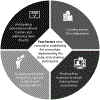Lessons Learned in Virtual Launch of an Antenatal Opioid Exposure Study During the COVID-19 Pandemic
- PMID: 39853217
- PMCID: PMC12040311
- DOI: 10.1097/NNR.0000000000000807
Lessons Learned in Virtual Launch of an Antenatal Opioid Exposure Study During the COVID-19 Pandemic
Abstract
Background: The COVID-19 pandemic prompted researchers to develop new ways to design and launch studies and recruit and retain participants. Pregnant women and infants are considered vulnerable populations in research, and families affected by substance use are particularly difficult to recruit and retain. Recruitment for studies involving medical technologies such as MRI can also be difficult due to misconceptions and fear of the technologies.
Objectives: This article aims to describe "lessons learned" during the launch of the Outcomes of Babies with Opioid Exposure (OBOE) study, including successes and challenges when working with high-risk infants and families and the importance of engaging participants through recruitment materials and retention efforts.
Methods: The OBOE study is a multisite prospective longitudinal cohort study comparing infants with antenatal opioid exposure to unexposed controls from birth to 2 years of age. Chi-square tests were used to examine refusal reasons among caregivers of eligible infants by exposure group and differences in 6-month retention among subgroups based on social determinants of health.
Results: Four factors were essential in establishing the consortium, implementing the study, and retaining participants: (a) creating venues for collaboration, (b) pivoting from in-person to virtual training, (c) anticipating potential enrollment barriers and addressing them directly, and (d) engaging participants through recruitment materials and retention efforts. With these factors in place, only 5% of caregivers of eligible opioid-exposed infants and 8% of control infants declined to participate in the study because of MRIs. Of 310 enrolled infants, 234 infants had attended the 6-month visit. Subgroups of enrolled infants were similar in retention at 6 months.
Discussion: Reporting our successes and challenges in setting up a nationwide consortium during the pandemic may help other consortia that need to be set up virtually. We anticipated that the serial MRIs would be a barrier to participation; however, few indicated they refused to participate because of MRIs, suggesting that our efforts to address this potential barrier to enrollment were successful.
Keywords: COVID-19; longitudinal study; opioid crisis; recruiting.
Copyright © 2025 Wolters Kluwer Health, Inc. All rights reserved.
Conflict of interest statement
The authors have no conflicts of interest to report.
Figures
Similar articles
-
Supplementing Consent for a Prospective Longitudinal Cohort Study of Infants With Antenatal Opioid Exposure: Development and Assessment of a Digital Tool.JMIR Form Res. 2025 Mar 4;9:e59954. doi: 10.2196/59954. JMIR Form Res. 2025. PMID: 40036491 Free PMC article.
-
Signs and symptoms to determine if a patient presenting in primary care or hospital outpatient settings has COVID-19.Cochrane Database Syst Rev. 2022 May 20;5(5):CD013665. doi: 10.1002/14651858.CD013665.pub3. Cochrane Database Syst Rev. 2022. PMID: 35593186 Free PMC article.
-
Sexual Harassment and Prevention Training.2024 Mar 29. In: StatPearls [Internet]. Treasure Island (FL): StatPearls Publishing; 2025 Jan–. 2024 Mar 29. In: StatPearls [Internet]. Treasure Island (FL): StatPearls Publishing; 2025 Jan–. PMID: 36508513 Free Books & Documents.
-
Behavioral interventions to reduce risk for sexual transmission of HIV among men who have sex with men.Cochrane Database Syst Rev. 2008 Jul 16;(3):CD001230. doi: 10.1002/14651858.CD001230.pub2. Cochrane Database Syst Rev. 2008. PMID: 18646068
-
Rapid, point-of-care antigen tests for diagnosis of SARS-CoV-2 infection.Cochrane Database Syst Rev. 2022 Jul 22;7(7):CD013705. doi: 10.1002/14651858.CD013705.pub3. Cochrane Database Syst Rev. 2022. PMID: 35866452 Free PMC article.
References
-
- American Academy of Pediatrics. (2021, January). Screen and intervene: A toolkit for pediatricians to address food insecurity. Food Research & Action Center. Retrieved from https://frac.org/wp-content/uploads/FRAC_AAP_Toolkit_2021.pdf
-
- Bann CM, Newman JE, Poindexter B, Okoniewski K, DeMauro S, Lorch SA, Wilson-Costello D, Ambalavanan N, Peralta-Carcelen M, Limperopoulos C, Kapse K, Davis JM, Walsh M, & Merhar S (2023). Outcomes of babies with opioid exposure (OBOE): Protocol of a prospective longitudinal cohort study. Pediatric Research, 93, 1772–1779. 10.1038/s41390-022-02279-2 - DOI - PMC - PubMed
-
- Caldwell BM, & Bradley RH (2003). Home observation for measurement of the environment: Administration manual. Family & Human Dynamics Research Institute, Arizona State University, 23–33.
-
- Cella D, Riley W, Stone A, Rothrock N, Reeve B, Yount S, Amtmann D, Bode R, Buysse D, Choi S, Cook K, Devellis R, DeWalt D, Fries JF, Gershon R, Hahn EA, Lai J-S, Pilkonis P, Revicki D, … Hays R (2010). The Patient-Reported Outcomes Measurement Information System (PROMIS) developed and tested its first wave of adult self-reported health outcome item banks: 2005–2008. Journal of Clinical Epidemiology, 63, 1179–1194. 10.1016/j.jclinepi.2010.04.011 - DOI - PMC - PubMed
-
- Centers for Disease Control and Prevention. (2021). Addressing opioid use disorder to improve maternal and infant health.
Publication types
MeSH terms
Substances
Grants and funding
LinkOut - more resources
Full Text Sources
Medical


